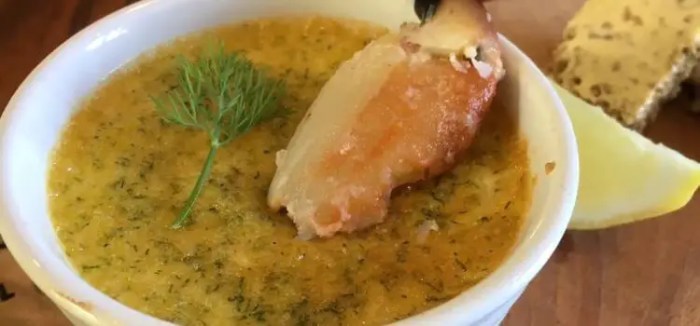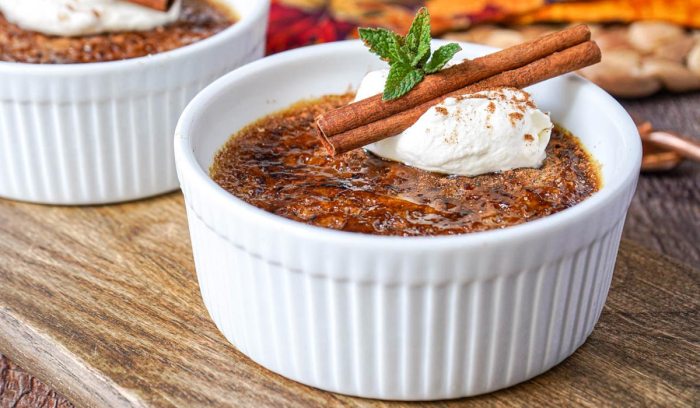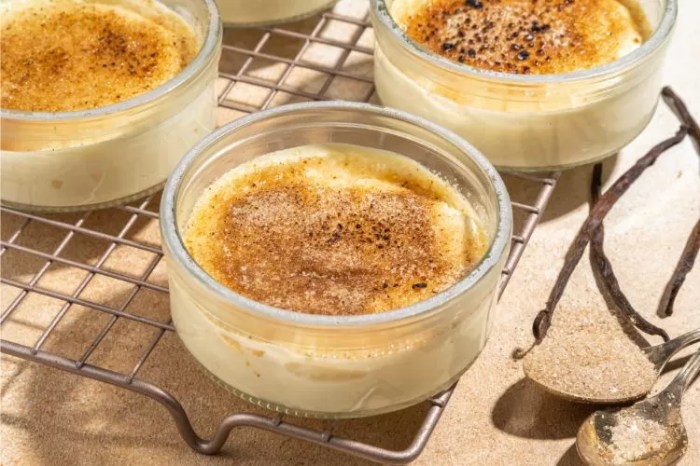
Prepare to embark on a delectable culinary journey with our exquisite crab brulee recipe. This extraordinary dish tantalizes taste buds with its harmonious blend of flavors and textures, leaving you craving for more.
Our comprehensive guide will lead you through every step of the preparation process, from selecting the finest ingredients to mastering the art of searing and baking. We’ll unveil the secrets behind the crab brulee’s captivating flavor profile and explore its rich cultural heritage.
Ingredients and Preparation: Crab Brulee Recipe

Crab brulee is a delicious and elegant dish that is perfect for a special occasion. The key to making a great crab brulee is to use fresh, high-quality ingredients and to follow the recipe carefully.
Ingredients
- 1 pound of crab meat, picked over and flaked
- 1/2 cup of heavy cream
- 1/4 cup of milk
- 2 eggs
- 1 egg yolk
- 1/4 teaspoon of salt
- 1/8 teaspoon of black pepper
- 1/4 cup of grated Parmesan cheese
- 1 tablespoon of chopped fresh parsley
Preparation
- Preheat the oven to 350 degrees Fahrenheit.
- In a medium bowl, whisk together the crab meat, heavy cream, milk, eggs, egg yolk, salt, and pepper.
- Stir in the Parmesan cheese and parsley.
- Pour the mixture into four ramekins.
- Place the ramekins in a baking dish filled with hot water.
- Bake for 25-30 minutes, or until the crab brulees are set.
- Let the crab brulees cool for a few minutes before serving.
Variations
- You can use any type of crab meat you like in this recipe. Dungeness crab, blue crab, and king crab are all good choices.
- If you don’t have heavy cream, you can use all milk instead.
- You can add other ingredients to the crab brulee mixture, such as chopped vegetables, herbs, or spices.
- You can also cook the crab brulees in a water bath on the stovetop. To do this, place the ramekins in a baking dish filled with hot water and bake in a preheated oven at 350 degrees Fahrenheit for 25-30 minutes, or until the crab brulees are set.
Culinary Techniques and Flavor Profiles
The crab brulee showcases a medley of culinary techniques that contribute to its distinctive taste and texture. The crab mixture undergoes searing to develop a golden-brown crust, enhancing its flavor and aroma. Sautéing, a technique involving gentle cooking in a pan with butter, allows the crab to absorb rich flavors from the aromatics, such as onions, garlic, and herbs.
Finally, baking the brulee in a water bath ensures even cooking, resulting in a delicate and creamy interior.
Flavor Profile
The crab brulee boasts a harmonious blend of flavors and textures. The succulent crab meat provides a delicate sweetness, while the sautéed aromatics impart a savory depth. The creamy custard base adds a velvety richness, balancing the seafood’s delicate flavor.
For a hearty and flavorful vegetarian meal, consider trying a chicken of the woods recipe . This edible fungus has a meaty texture that resembles chicken, making it a great substitute in a variety of dishes. Whether you’re grilling, sautéing, or roasting, the possibilities are endless.
The caramelized sugar topping adds a touch of sweetness and a satisfying crunch, creating a delightful contrast to the soft interior.
The chicken of the woods mushroom is a unique and delicious edible mushroom that can be found in forests throughout the world. If you’re looking for a delicious and easy-to-make recipe for this mushroom, check out the chicken of the woods recipe from Salem State University.
This recipe is simple to follow and yields a delicious and flavorful dish.
Presentation and Plating Suggestions

The presentation of your crab brulee can elevate the dining experience and tantalize the senses. Consider these creative ideas to showcase your culinary masterpiece:
Garnishes
- Fresh herbs like chives, dill, or parsley add a vibrant pop of color and enhance the flavor.
- Microgreens, such as pea shoots or watercress, provide a delicate and refreshing contrast.
- Citrus zest, from lemon or lime, offers a bright and tangy accent.
Accompaniments
Complement the crab brulee with these delectable accompaniments:
- A drizzle of lemon or lime juice adds a burst of acidity to balance the richness of the dish.
- A dollop of crème fraîche or sour cream provides a creamy and tangy counterpoint.
- Toasted bread or crackers serve as a perfect base for scooping up every last bite.
Plating Techniques
Arrange your crab brulee in a visually appealing manner:
- Serve in individual ramekins for a classic and elegant presentation.
- Create a tower by stacking multiple ramekins for a dramatic effect.
- Arrange the crab brulee on a slate or wooden board for a rustic and natural touch.
The visual appeal of the crab brulee enhances the dining experience by stimulating the appetite and creating a sense of anticipation. It also demonstrates the chef’s attention to detail and artistry.
Complementary Dishes and Beverages, Crab brulee recipe
Pair the crab brulee with these complementary dishes and beverages for a harmonious meal:
- A light and crisp salad, such as a mixed greens salad with a vinaigrette dressing, balances the richness of the crab brulee.
- A seafood-based main course, such as grilled salmon or pan-seared scallops, complements the flavors of the crab brulee.
- A chilled glass of white wine, such as a Sauvignon Blanc or Pinot Grigio, pairs well with the acidity and richness of the dish.
Origin and Cultural Significance

The origins of crab brulee can be traced back to the 18th century in France. It was originally a savory dish made with crab meat, eggs, and cream, and was often served as an appetizer or main course. Over time, the dish evolved into a sweeter dessert, with the addition of sugar and vanilla.
It is now a popular dish in many countries around the world, and is often served as a special occasion dish.
Cultural Influences
Crab brulee has been influenced by a variety of cultures over the years. The French origins of the dish are evident in its use of butter, cream, and eggs. The addition of sugar and vanilla is a nod to the Spanish and Portuguese influence on French cuisine.
In the United States, crab brulee is often made with blue crab, which is a popular seafood in the Chesapeake Bay region.
Historical Context
Crab brulee was first created during a time of great culinary innovation in France. The 18th century was a time of great experimentation in the kitchen, and new dishes were being created all the time. Crab brulee was one of many new dishes that were created during this time, and it quickly became a popular favorite.
Regional Variations
Crab brulee is a versatile dish that can be made with a variety of ingredients. As a result, there are many regional variations of the dish. In some regions, crab brulee is made with blue crab, while in others it is made with Dungeness crab or snow crab.
If you’re looking for a more specific guide, check out this chicken of the woods recipe from Salem. It provides step-by-step instructions and helpful tips for preparing this delicious fungus. From foraging techniques to cooking methods, you’ll find everything you need to know to create a satisfying and flavorful meal.
The dish can also be made with a variety of different spices and herbs, depending on the region.
Nutritional Value and Health Benefits
Crab brulee offers a diverse range of nutrients that contribute to its overall health benefits. Its macronutrient profile boasts a substantial amount of protein, essential for muscle growth and repair. Furthermore, it is a rich source of omega-3 fatty acids, known for their anti-inflammatory properties and potential benefits for heart health.
Vitamins and Minerals
In addition to its macronutrients, crab brulee contains an array of vitamins and minerals. It is a good source of vitamin B12, which is essential for nerve function and red blood cell production. It also provides a significant amount of selenium, an antioxidant that plays a crucial role in thyroid function and immune system health.
Health Benefits
Consuming crab brulee can offer several potential health benefits due to its nutrient-rich composition. The high protein content supports muscle development and maintenance, while the omega-3 fatty acids may contribute to reducing inflammation and improving heart health. Additionally, the vitamins and minerals found in crab brulee support various bodily functions, such as nerve health, red blood cell production, thyroid function, and immune system strength.
Incorporating into a Balanced Diet
To incorporate crab brulee into a balanced diet, consider consuming it in moderation as part of a varied and nutritious meal plan. Its rich flavor and nutritional value make it a suitable addition to salads, pasta dishes, or as a standalone appetizer.
However, individuals with shellfish allergies should avoid consuming crab brulee.
Final Conclusion

As you savor the last bite of your delectable crab brulee, let the flavors linger on your palate, a testament to the culinary artistry that went into its creation. Whether enjoyed as an elegant appetizer or a decadent dessert, this dish is sure to impress and delight your guests.
Essential FAQs
What is the origin of crab brulee?
Crab brulee originated in France, where it is known as “crabe brûlé.” It is believed to have been created in the early 19th century.
What type of crab is best for crab brulee?
Dungeness crab or blue crab are commonly used for crab brulee due to their delicate and sweet flavor.
Can I make crab brulee ahead of time?
Yes, you can prepare the crab brulee up to 24 hours in advance. Simply cover and refrigerate the ramekins until ready to bake.





